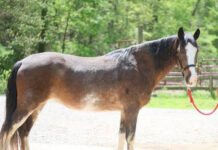Since equine protozoal myeloencephalitis (EPM) can leave a horse neurologically damaged in spite of treatment, conscientious horsemen seek ways to prevent this devastating disease. There are 2 ways to protect a horse—with vaccination, and limiting exposure to the protozoa (Sarcocystis neurona) by keeping feed and water from being contaminated by opossum feces.
Rob Keene, DVM (who works at Fort Dodge Animal Health) says Fort Dodge is also working with Ohio State University to develop a challenge model, to reproduce EPM in the laboratory so the vaccine can be tested more fully. A field performance study is being done at Texas A&M and the University of Florida, using cases from eight additional veterinary teaching hospitals and 3 private practices.
Keene says the main thing in the decision about whether or not to vaccinate your horse is risk factors. “If you live in an area where opossums are in abundance, or use feeds that are not heat-treated or that might be contaminated with opossum feces, your horses are at risk. Stress seems to be involved in precipitating the disease. Horses engaged in stressful careers, heavy training, being frequently transported or subjected to any other kinds of stress could benefit from vaccination,” he says.
“Before a horse becomes exposed to risk factors, it should be vaccinated. A 2 dose series 3 to 6 weeks apart, followed by an annual booster, seems to protect most horses. If you are in a situation where you can’t control exposure to opossums, however, some folks are thinking about twice a year vaccination, but this has not been established as a recommendation,” says Keene. “If a horse has been treated for EPM and recovered, many of the universities are suggesting that the horse be vaccinated, along with any other horses in that group. If you have one horse on the farm that has EPM, the risk is there for others.”
MINIMIZE EXPOSURE – Efforts should be made to keep opossums away from horses, horse feeds, and water sources. “The University of Florida has successfully set up opossum-proof facilities. And Ohio State uses electric fences to keep opossums from getting into pastures. It’s expensive, but you can fence them out of paddocks and pastures,” says Keene.
To protect feeds, use covered containers for grain, pellets and supplements, and a fence around haystacks that no opossum can get through (small mesh netting). Be careful about purchased feed; always use heat-treated grains and pellets.
“Just because it’s in a pellet doesn’t mean it’s safe. It may not have been heated enough. Contact the feed manufacturer, to find out. Feed must be heated to at least 156 degrees Fahrenheit in order to kill the protozoa,” Keene says. “A recent paper by Dr. William Saville (Ohio State University) on various disinfectants that might be helpful around the barn indicated that there’s not much that is effective against the EPM organism except steam cleaning. Heat is the best plan for disinfecting premises.”
Treatments are available. Ask your veterinarian.
Heather Smith Thomas is a rancher and freelance writer based in Salmon, Idaho.





I have 2 mustang colts from BLM since July 2006 them have gotten diarrhea the local vet dont know what i put them on fast tract to help but i need help. any advice will do KDG
I think it is totally irresponsible to be advocating a vaccine that has not been determined safe by the FDA. My horse has neurological deficits from EPM and we will never know if it was caused from the vaccine, which was administered to my horse for two years – without having received the second shot in the series or the booster, of if he got it from exposure to opposums. Veterinarians need to act responsibily and carry through with the vaccine protocol if they plan on advocating and using the vaccine. It’s one thing to report on a possible vaccine and it’s quite another to give a false impression that the vaccine is safe for general use.
I think I might have already read this but not sure. Worth a second read.
Actually, a very good question! If your horse tests positive in his blood serum, then tests negative in a spinal tap, then you start the EPM Vaccine, what are his chances of not getting this dreded disese? Help me with this one if you can!
Thanks for this great article! It helped on a science report I had to do!
good info
great article
I had no idea what it was at first!
good information!
g
good
good to know
This is a wonderful well written article. She goes through everything in the smallest detail.
There was one thing that I did not see in the article: the “natural predator” (other than a gun or rifle) of those ugly, nasty, opossums.
opossum!Never thought!
when printing this article page 2-3-4 come out blank please adjust
good information.
like this article
thanks for showing this article!
WHY don’t all Vets know about this vaccination????$$$$$$$$$$$$$$
Thanks for this informative article..
From everything I’ve heard from vets around here, the vaccine has NOT been found to be very effective – the number that sticks in my head is 40% – and once a horse has been vac’d for EPM, they will ALWAYS test positive for it, even if they have some other cause of their symptoms. I guess all 3 vets need to go back to school………
Thanks for the information.
This info on EPM is out dated. The Vaccine is no longer available because it did not work. Also contaminated feces is bailed-up in the hay out in the field so how you store it has little effect on contamination.